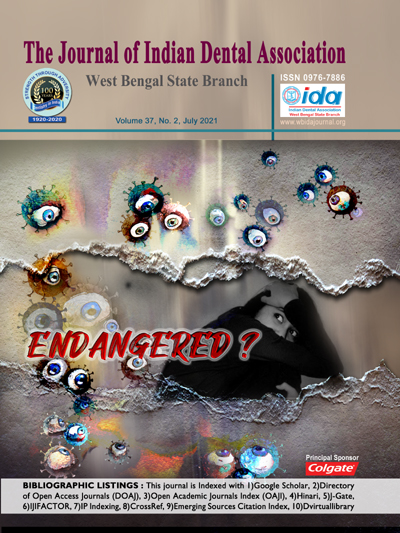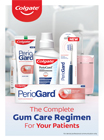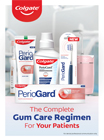Upcoming Events
1. Article Title.
2. Author Details.
3. Abstract.
4. Keywords.
5. Corresponding Author details.
July 2021
Volume : 37
No.: 2

Dr. Arkajit Goswami,Dr. Partha Pratim Choudhury,Dr. Hussain Lokhandwala,Prof. (Dr.) Amal Kumar Chakrabarti,Dr. Rup Kumar Das,Dr. Bhupender Kaur
Abstract: Presurgical infant orthopaedics has been employed since 1950 as an adjunctive neonatal therapy for the correction of cleft lip and palate. The presurgical nasolaveolar molding (PNAM) technique reduces the severity of the initial cleft and nasal deformity before lip surgery. This enables the surgeon to repair a cleft deformity that is minimal in severity. Long term studies on PNAM therapy showed better lip and nose form, reduced oronasal fistula and labial deformities, 60 % reduction in the need for secondary alveolar bone grafting. This article describes a case report where a 28 days old infant having unilateral cleft lip and palate is treated with PNAM procedure that produced considerable reduction in size of cleft allowing successful surgical lip closure.
Dr. Rijinraj J.R,Dr. H.D. Adhikari,Prof. (Dr.) Abhijit Niyogi,Dr. Pampa Adhya,Dr. Kurchi Mandal
Abstract: Traditionally, Direct Pulp Capping (DPC) procedure using Calcium hydroxide is advocated for management of pinpoint pulp exposure due to iatrogenic and traumatic causes. But in cases of carious exposure, pulpectomy/ Root canal therapy is the convention as DPC with calcium hydroxide in such situation is unpredictable and outcome is uncertain. Bioactive materials such as MTA and Biodentineare being used successfully recently due to their effect on undifferentiated mesenchymal stem cells of pulp. But there are some drawbacks with these materials. Platelet rich fibrin (PRF), a platelet concentrate has become popular in the field of endodontics. It is rich in growth factors and cytokines. It utilizes the undifferentiated cells and differentiate them to odontoblasts, allows them to proliferate for the formation of dentinal bridge effectively at the site of exposure. But clinical report using PRF in DPC is sparse. Keeping this in view, DPC was performed on cariously exposed pulps with autologous PRF in three cases. Detailed procedure and result of DPC upto 12 months follow up in one tooth and 6 month in another two have been reported here. IOPAR revealed definite calcific bridge formation across the breach in all the cases.
Dr. Swapan Mazumder,Dr. Inamuddin .,Dr. Aritra Chatterjee,Dr. Soubhik Pakhira,Dr. Kuldip Mukhopadhyay,Dr. Shivakumar L
Abstract: Maxillary canines are the most common impacted tooth, following the third molar teeth. This is mostly due to the fact that they have longest period for development and the most tortuous route to full occlusion. Deviation from eruption path leads to abnormal inclination of the erupting cuspid, sometimes it may fail to erupt. Removal of impacted canines in ectopic position is always challenging due to close approximation of vital structures such as maxillary antrum, nasal cavity or sometimes infraorbital neve. Abnormal orientation of the long axis of the tooth makes the surgical accessibility more difficult for successful removal of it. Here we present an extremely rare case of impacted cuspid which was found to be protruding through the skin and dermal appendages outside the mouth in the ala region. As it was found to be within the 'dangerous area of face', an extreme caution regarding surgical planning and execution prevented undue postoperative complications.
Dr. Jayanta Saha,Dr. Abhishek Khatua,Dr. Mustafizur Rahaman,Dr. Asish Das
Abstract: Pleomorphic adenoma of minor salivary glands is a rare benign tumour. It is the most common salivary gland tumour of the minor salivary glands. It may be most commonly seen in the hard palate and unusually areas like the buccal mucosa, labial mucosa, lips among others. Presents as a submucous mass, it is a slow growing neoplasm that is benign in nature. In this case report we are presenting a rare case of simultaneous occurrence of Pleomorphic adenoma at the hard palate and labial mucosa.
Dr. Raju Biswas,Dr. Santanu Mukhopadhyay
Abstract: Supernumerary teeth and fusion are developmental anomalies of teeth affecting the primary as well as permanent dentition. Fusion occurs mostly in the mandibular anterior region while supernumerary teeth have a definite predilection for the anterior maxilla. In this article we report an extremely rare case of a fused maxillary supernumerary molar in the primary dentition in a three-year-old girl. The crown morphology of the supernumerary tooth resembled with the two primary first molars fused together. The anomalous tooth demonstrated two separate pulp chambers, six cusps and possibly six roots. An erupted supernumerary maxillary lateral incisor was also observed. As the patient presented with pain and interference with occlusion, non- surgical extraction of the fused supernumerary molar was performed.
Dr. Shelly Sharma,Dr. H.D. Adhikari,Prof. (Dr.) Abhijit Niyogi,Dr. Parthasarathi Mondal,Dr. Amrita Ghosh
Abstract: Regenerative Endodontic Procedures (REPs) has been described as a 'paradigm shift' in the treatment of necrotic immature teeth, since it fosters continued root maturation. REPs have also been used to successfully treat human mature permanent teeth with necrotic pulps and apical periodontitis. However, there is no consensus in using REPs in endodontically treated permanent teeth with persistent periapical periodontitis instead of non-surgical retreatment. AIM:- The aim of this case series was to describe REPs performed in five endodontically treated permanent teeth with persistent periapical pathology using Platelet Rich Fibrin (PRF) as a scaffold, with the objective to eliminate the clinical signs and symptoms and to achieve complete resolution of periapical pathology along with regaining positive response to pulp sensibility testing after REPs. RESULTS:- All cases were found asymptomatic at 3,6,9 and 12 months follow up visits. Radiographic examination revealed complete resolution or remarkable reduction in the size of the periapical lesions in all five teeth along with apical closure of open apices of two teeth. Formation of calcific bridge was noted in one tooth. CONCLUSION:- REP can be a viable treatment option for nonsurgical retreatment of nonvital permanent teeth.












